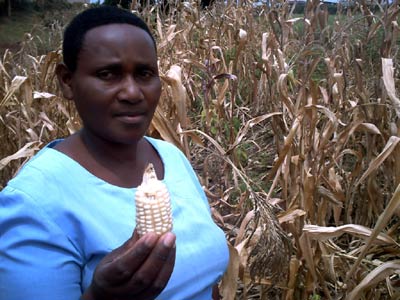 |
Ben Twinomugisha describes small-scale farmers' livelihoods and food security strategies in Uganda. |
| He argues that traditional approaches to managing extreme weather events can provide a basis for adaptation to climate change, but small-scale farmers need support to make the most of the opportunities these strategies may afford. | |
| The author is a Climate Change Adaptation and Disaster Risk Reduction Specialist with Choice Africa and a former fellow of the Capacity building in the Least Developed Countries on Adaptation to Climate Change (CLACC) programme. | |
A typical Ugandan small-scale farmer is at the mercy of nature when it comes to agricultural production and due to institutional deficiencies has limited access to innovative approaches to help improve production. This article reports on a study that documents climate change impacts on small-scale farmers and reveals that indigenous adaptation options are the best way for these farmers to ensure food security and raise their income.
Indigenous knowledge is an integral part of Ugandan farmers' lives and local coping strategies provide the foundation for their own ideas on how to survive during harsh times. Current adaptation strategies are based on existing knowledge on how to cope, an understanding of seasonality and past experience. Much of this knowledge is passed on from one generation to another.
The study analysed the adaptation knowledge, attitudes and practices of small-scale farmers in the Mubende and Nakasongola districts of Uganda. It used qualitative research tools such as focus group discussions, key informant interviews and semi-structured interviews and analysis of local seasonal calendars and social maps. Myths, beliefs and traditional practices in relation to seasonal changes were identified, along with a list of the climate change-related events the community was experiencing. Community-based socioeconomic infrastructure that could support both climate change adaptation and mitigation was also explored. The study mapped out small-scale farmers' resources, livelihoods, income capacities and vulnerabilities to likely adverse climate change impacts and identified the best interventions and adaptation measures.
Over 75 per cent of people in the study areas depend on subsistence farming as their main source of livelihood. Knowledge about changes in rainfall, drought and the seasons for crop and animal diseases help small-scale farmers survive. Traditional indigenous production strategies are holistic and comprehensive and help small farmers cope with weather extremes. They also aim to conserve and enhance natural ecological processes and maintain a balance with nature.
Traditional resource-use strategies revolve around certain principles. First among these is the use of natural processes and resources. For example, farmers generally avoid eliminating all weeds in the soil because they can counter the impact of pests that attack certain crops. Community elders explained how traditional knowledge considers the interdependencies between food, pest-control and the maintenance of soil health in the same breath.
The second principle is based on the need to maintain crop diversity to maximize output as well as protect against climatic risks. Traditional principles also necessitate a balance between crops and animals and birds. For instance, the sale of goats or chickens is often the first line of defence in cases where families need cash for emergencies.
The study also showed the importance of the traditional care economy. All indigenous knowledge systems include networking and a sharing of intellectual property amongst different community members as part of their moral economy.
Communities use traditional technologies to help increase agricultural productivity. These technologies are mainly built on an understanding of how soils are renewed and how to increase soil fertility whilst avoiding erosion. They include information on contour cropping, how to construct and use fencing and how best to manage mixed farming or agro-forestry to full effect. Traditional technologies also help control and manage pests.
Much of this knowledge has tremendous value in the context of crop production and the threat of climate change. Local knowledge helps interpret changes in the weather and seasons, which are key ingredients of successful adaptation. And maintaining the distinction between crops grown for food and for sale is also an important component of traditional knowledge on adaptation. There is, however, a need to understand the limits and constraints of these practices as well as the opportunities that they provide when it comes to climate change.
Small-scale farmers in the study area have observed several changes in recent years and can no longer effectively predict seasonal changes. Community members do not know the phrase "climate change" but the older people (of 50 years or more) testified that there has been a shift in when the rainy season starts. When the rain comes, it is also interspersed with dry spells. Such unpredictable seasonal changes are having a wide range of inter-related negative impacts on farmers' livelihoods and incomes. Long-term unpredictable drought events are also limiting agricultural productivity since crop farming is mostly rain-fed. Most small-scale farmers grow local varieties of crops such as of maize and cassava that mature late and are, therefore, affected worse by heavy rains and drought.
In addition to unpredictable seasonal changes, small-scale farmers already face multiple barriers to effective agriculture productivity. Few can afford the inputs and technologies needed to boost production and access to improved seeds, markets, credit facilities and relevant information is limited. People suffer from food insecurity, increasing food prices coupled with limited income generation opportunities, extreme drought, poor soils and crop and animal diseases. They have limited access to land and control over land tenure and there are no early warning systems that could alert farmers to likely future climatic catastrophes. These all add to existing poverty-related problems and are all barriers to effective climate change adaptation.
Knowledge and skills to help small-scale farmers adapt to these changing seasons are limited. High levels of illiteracy contribute to this general lack of awareness and limit the adoption of new agricultural production technologies. Government extension and education services are also limited in scope and tend to target marketing rather than production. They use an approach that supports a model group of farmers in the hope that these farmers will share their knowledge with others through a trickledown effect. This approach has not yielded significant results. Farmers also greatly outnumber available extension workers, with the present ratio stagnating at about 1:100,000.
 |
|
Jane Nabwami, a small-scale farmer in Mubende and
one of many whose gardens were hit by drought in
2009, holds an undersized maize cob from her garden
© Ben Twinomugisha |
In order to survive, farmers try to secure household food security using food reserves kept in granaries for those few families who have them or kept in baskets and sacks in the house for those that do not. Farmers also grow food crops that can stay in their gardens for long periods, especially tubers like cassava, sweet potatoes and yams. Almost all households have a kitchen garden with vegetables and fruits grown to improve family nutrition. Farmers find that these strategies are more effective at ensuring food security than market-based strategies, which they regard as too risky. Experience has taught them that, when they sell their food crops at harvest time, the prices are usually low and, by the time there are food shortages, market prices are usually too high for them to afford.
Government extension programmes, such as the Plan for Modernization of Agriculture, contain significant climate change adaptation content, including information on the development of drought-resistant cultivars, the provision of water for production, the dissemination of agricultural information, training and research. Conversely, the sectoral programmes of the Plan for Modernization of Agriculture, such as the National Agricultural Advisory Services, are top-down in design. This and similar policies have faced challenges during the implementation stage. The results of such policies have been of little use to poor people who still depend on rain-fed agriculture and lack good land, irrigation facilities and financial resources.
Small-scale farmers are highly vulnerable to future changes in climate and seasonal variability. The impacts of a drought in 2009 on the study community demonstrated this to full effect. As existing climate variability continues to be high and conditions become warmer and possibly wetter, the community is increasingly at risk of the catastrophic impact of climate change on infrastructure, agriculture the environment and ecosystems.
Impacts are felt at several levels. Whilst individual farmers are most immediately affected, families and households will also be adversely impacted. These effects combine in turn to exert negative impacts on communities, regions and the whole nation. Impacts on households can alter the composition and structure of whole communities. For example, changing household composition due to out-migration can influence the price of labour, land and credit at the community level. Changes in aggregated savings rates and credit markets and reduced community expenditure could significantly alter levels of community financial capital. The scale of community-level impacts will depend upon how prevalent negative climate impacts are and upon the local social, economic, cultural and agro-ecological environment. Severe household-level climate change impacts in the hardest hit areas will likely be paralleled at the community level.
What can be done to improve the capacity of the rural people to cope and adapt to climate change?
In rural livelihood systems, food security is the critical adaptation challenge. At farm level, the diversification of production activity, including off-farm income drawing on local systems, to enable drought- and flood-proof livelihood activities is essential. Building rural infrastructure relevant to poorer people will facilitate sustainable adaptation. There is urgent need to support irrigation schemes that are affordable for poorer farmers. For example, investment in treadle pumps can lead to almost a doubling in production. There is also a need for the promotion of early maturing and drought-tolerant crop varieties through farmer-led research.
The capacity of the Ugandan Meteorological Department needs to be strengthened in order to give accurate and timely information on likely weather and rainfall patterns. This effort should promote an early warning system that integrates information dissemination. The government should plan for climate contingencies and develop contingency plans that should anticipate what farmers will do, how markets will react and what roles government authorities need to play. The National Adaptation Programme of Action process should enhance research and capacity-building needs.
Farmers need to be provided with both the space and capacity to engage in climate change policy issues. An awareness strategy regarding national climate policy should be developed. Education and awareness creation on climate change among governments, institutions and individuals should be viewed as a necessary step in promoting adaptation to climate change.
Finally, adaptation activities must undertake a bottom-up approach to diversified development activities that is gendered. The empowerment of women in the agriculture sector must receive attention as it remains a significant challenge to adaptation.
Further information
Ben Twinomugisha, PO Box 1433, Kampala, Uganda. Email: ben@choiceafrica.org. Web: www.choiceafrica.org.